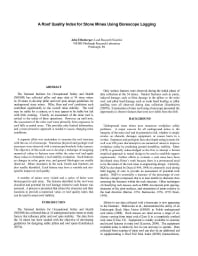Mining Publication: A Roof Quality Index for Stone Mines Using Borescope Logging
Original creation date: July 2009
Authors: JL Ellenberger
NIOSHTIC2 Number: 20035815
Proceedings of the 28th International Conference on Ground Control in Mining, July 28-30, 2009, Morgantown, West Virginia. Peng SS, Barczak T, Mark C, Tadolini S, Finfinger G, Heasley K, Luo Y, eds., Morgantown, WV: West Virginia University, 2009; :143-148
The National Institute for Occupational Safety and Health (NIOSH) has collected pillar and span data at 34 stone mines in 10 states to develop pillar and roof span design guidelines for underground stone mines. Pillar, floor and roof conditions each contribute significantly to the overall mine stability. The roof may be stable for a century, or it may appear to be stable but fail with little warning. Clearly, an assessment of the mine roof is critical to the safety of these operations. However, up until now, the assessment of the mine roof came primarily from exposures in roof falls or portal areas. This provides only limited information, and a more proactive approach is needed to assess changing mine conditions. A separate effort was undertaken to examine the roof structure with the use of a borescope. Numerous physical and geologic roof structures were observed with a stratascope/borehole video camera. The objective of this work was to develop a technique of assigning numerical values to features seen within the mine roof and apply those values to formulate a roof stability evaluation. Such features as changes in color, grain size, and general lithologies are readily observed. Minor structures in the rock, fossils and fractures are also readily identified. Each feature may have a variable and site-specific impact on roof quality. A number of mines were visited and a series of holes were borescoped in each mine. The features identified in the roof were classified and potential for roof damage related to each feature was assessed. A process is presented that relates the structures and their locations to provide a numerical value, or roof quality index that can be used to assess roof stability.

NIOSHTIC2 Number: 20035815
Proceedings of the 28th International Conference on Ground Control in Mining, July 28-30, 2009, Morgantown, West Virginia. Peng SS, Barczak T, Mark C, Tadolini S, Finfinger G, Heasley K, Luo Y, eds., Morgantown, WV: West Virginia University, 2009; :143-148